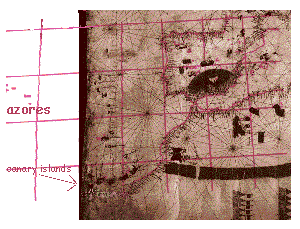
This 1440 chart has the approximately correct longitude of the Mediterranean. The Iberian Muslim astronomer Az-Zarqali (Azarquiel) correctly determined the longitudinal extent of the Mediterranean in the 11th century AD. Thus the Canary Islands show up exactly where they should be.
But why does the chart show the Azores in the wrong place?
a) Were the chart makers trying to hide the distance from sailors who might be fearful of the open ocean? Might chart makers have been trying to mislead the ordinary sailors on board?
b) Or was the reason more prosaic? Did they just run out of paper, or not want to waste paper drawing a vast expanse of ocean?